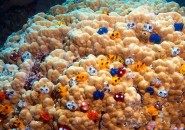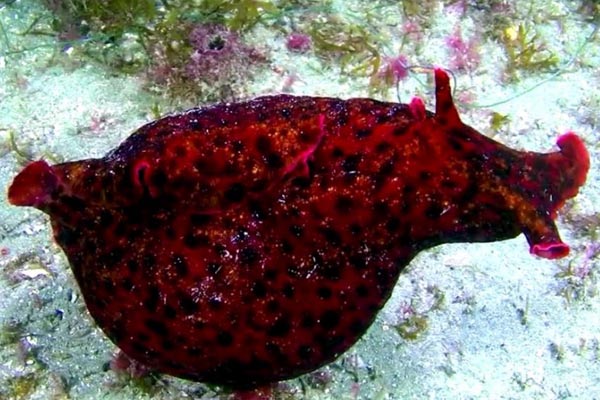 Jean-Michel Cousteau and marine biologist Holly Lohuis
Jean-Michel Cousteau and marine biologist Holly Lohuis
Jean-Michel Cousteau and marine biologist Holly Lohuis

 PLANKTON
PLANKTON
PLANKTON

As much as 80 percent of all life on Earth is in the ocean.
Most of it is nearly invisible, and fragile, a world of Plankton, drifting and wandering.
The smallest particles are plants, called phytoplankton, and the larger are animals called zooplankton. Life as we know it depends on this tiny world, not just for the ocean, but for the planet, because thanks to photosynthesis, phytoplankton produce more than half the oxygen on Earth. So, every other breath we take is a gift from the sea.
 BASKET STAR
BASKET STAR
BASKET STAR

The basket star is one of the strangest animals that livesnestled in the branches of a soft coral and that looks like a tangled weed. It is a creature of the night which unfurls, to feed. It has no eyes, no blood, no head and its arms stretch as much as three feet wide to grab food.
 ANEMONE & CLOWNFISH
ANEMONE & CLOWNFISH
ANEMONE & CLOWNFISH

This giant anemone is an animal with a clownfish as a symbiotic partner, meaning they both benefit. To eat, it stings small fish with its venomous tentacles but the clownfish is immune. Protected in a coat of mucus, the clownfish chases away fish wanting to eat the anemone’s tentacles. In return, it finds unlikely shelter.
 GIANT CLAM
GIANT CLAM
GIANT CLAM

The giant clam may weigh over 400 pounds and live for more than a hundred years.
Growing in the flesh of this huge creature are tiny, plantlike organisms called zooxanthellae. The nutrients they directly provide make up two-thirds of what the clam needs. Stuck in one place, the clam filters plankton for the remaining one-third of its food.
 ARROW CRAB
ARROW CRAB
ARROW CRAB

The arrow crab is gymnast, beachcomber and paratrooper in search of the best place to eat. These solitary creatures will eat whatever they find and fight each other for territory.
 BANDED CORAL SHRIMP
BANDED CORAL SHRIMP
BANDED CORAL SHRIMP

With peppermint stripes and long, waving antennae, the banded cleaner shrimp certainly isn’t hiding—it’s advertising. They wave their antennae to signal that they’ll clean parasites and dead skin off any fish and get a meal from the pickings.
This shrimp is well equipped for eating, with 6 pincers, and picks up scraps anywhere. They’re partners for life, and claim their territory for as long as a year.
 SEA CUCUMBER
SEA CUCUMBER
SEA CUCUMBER

The sea cucumber vacuums the ocean floor, sucking up morsels that have fallen from other meals. They have tentacles that extend from its mouth, sensing food. Providing an overlooked service, it cleans up, and eats the debris.
 OCTOPUS
OCTOPUS
OCTOPUS

The octopus was called by Jacques Cousteau “the soft intelligence”, the smartest of invertebrates, and a genius at disguise. This mobile magician uses jet propulsion to swim, expelling water through its siphon. It can hunt using its body as a tent. Its tentacles grab prey underneath for a venomous bite from its beaked mouth. It can flash warnings, or use camouflage to simply disappear by changing color and texture.
Without any bones, it can squeeze into anywhere and just disappear.
 GOBIES/BLENNIES
GOBIES/BLENNIES
GOBIES/BLENNIES

Thousands of species of gobies and blennies hide on the reef, many less than half an inch long. More than one third of all fish on certain reefs are gobies, an important source of food to larger fish, so they have to hide.
 CHRISTMAS TREE WORMS
CHRISTMAS TREE WORMS
CHRISTMAS TREE WORMS

On the reef, they look like a plant, but it’s an animal. Christmas tree worms can’t move around, and still must eat. They’re part of a hungry garden of creatures that filter tiny meals of drifting plankton and are easily frightened.
 HERMIT CRAB
HERMIT CRAB
HERMIT CRAB

The hermit crab is a crustacean: there are about 500 different species of hermit crabs around the world. Most species live on the ocean floor, but many live on land.
They can live 10 years or more, changing shells, molting several times throughout their lives and growing up to six inches in length. Not a true crab, it uses other animals’ old shells for protection.
 SEA HARE
SEA HARE
SEA HARE

The sea hare is a snail without a shell which has a secret protection—no matter how vulnerable it seems. The plant-like material, or algae, it eats makes it taste bad, and predators know it. These acrobats of the current tumble along with no need to hide, thanks to the tiny algae they eat, protecting them from the inside out.
 COLD WATER SEA HARE
COLD WATER SEA HARE
COLD WATER SEA HARE

The cold-water cousin of the sea slug also tastes bad, from eating red algae. This sea hare may grow to enormous size — over fifteen pounds. It, too, is a soft-bodied survivor.
 SQUID
SQUID
SQUID

Squid find safety, and survival, in the simple enormity of their numbers.
In fierce competition, squid mate only once in a short lifetime that lasts less than a year. To reproduce they attach millions of egg cases to the seafloor. Each one of these capsules contains hundreds of eggs.
 Crown of thorns
Crown of thorns
Crown of thorns

The crown of thorns seastar can grow to over two feet wide and have up to 19 arms and a forest of venomous spines. It devours living coral and breathes through black gills on its skin. It’s a carnivore, eating coral polyps. It spreads its stomach outside its body and directly digests living coral polyps.
 LION FISH
LION FISH
LION FISH

The beauty and grace of the lion fish are a disguise. The tall fins on its back have venomous stingers. Tentacles above its eyes are decoys to attract fish. Its stripes and polka dots are meant to confuse. And its elegant fins are a cloak to herd and trap small fish. One large lion fish can consume 40 fish an hour.
The lion fish was brought from the Pacific, and accidentally released onto Caribbean reefs, where there is no natural predator to control it.



























































